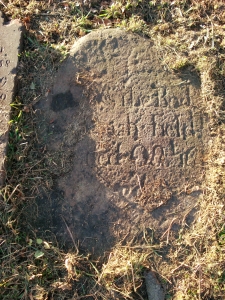An article published on my personal site recently takes a look at the locations of the early Dutch Reformed burial places of Albany from the 17th-century to the removal of graves to the Church Grounds at the Rural Cemetery. Included is the rarely mentioned first burial ground on the north side of Fort Orange.
Tag Archives: dutch reformed
Featured Gravestone – Anne Veeder
Material: Brown sandstone
A simple sandstone marker with darkening of surface and damage to upper left corner, but a generally legible inscription.
Inscription: In Memory of Ann daughter of Volkert S. & Anne Veeder who departed this life July 9, 1795 aged 17 months.
Ann Veeder was one of five children of Albany merchant and fire inspector Volkert S. Veeder (1760-1812) and his wife, Anna Spann (married 1786).
Filed under Featured Gravestones
Jeremiah Field and The Headstone That Was Not Lost
 One of the older sandstone slabs at the edge of the Dutch Reformed section of the Church Grounds and previously pictured in the post, The Oldest Stones, can now be identified as a gravestone long assumed to have been discarded after it was discovered during mid-19th century excavations near the site of the old Dutch Reformed burial ground on Beaver Street near South Pearl. The article posted yesterday, Ancient Albanians, provided the needed details to identify the stone which was described as “thrown out” along with that of Albany’s second Mayor, Johannes Abeel.
One of the older sandstone slabs at the edge of the Dutch Reformed section of the Church Grounds and previously pictured in the post, The Oldest Stones, can now be identified as a gravestone long assumed to have been discarded after it was discovered during mid-19th century excavations near the site of the old Dutch Reformed burial ground on Beaver Street near South Pearl. The article posted yesterday, Ancient Albanians, provided the needed details to identify the stone which was described as “thrown out” along with that of Albany’s second Mayor, Johannes Abeel.
Jeremiah Field and The Headstone That Was Not Lost at gardenalley.net
Filed under Uncategorized
The Book of Burials – The Churchyard
The greatest percentage of interments records in The Book of Burials are those from the churchyard. Established around 1676 on Beaver Street east of South Pearl, this churchyard was the successor to the burial ground alongside the Dutch Reformed Church at Broadway and State Street. In addition to new burials, it received remains moved from its predecessor. As this graveyard ran out of room, the headstones would be laid flat over the graves and a new six-foot deep layer of earth spread over it. New graves would then be opened in this layer above the older burials, a process repeated at least three times.
In 1806, the Second or Middle Dutch Reformed Church was constructed on the site and, again, the remaining headstones were laid over the graves and covered with earth. Burials here had, by this time, ended with the opening of a municipal cemetery just south of the Capitol and, later, with the establishment of the State Street Burying Grounds which included two large sections for Dutch Reformed interments. Continue reading



